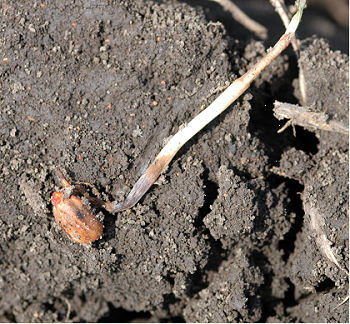3 MIN READ
Anhydrous Ammonia Injury to Corn
June 6, 2021
Introduction
Anhydrous ammonia applications shortly after corn planting can injure corn seedlings particularly under cold and dry soil conditions. Separating the corn seed/seedling by either time or distance from anhydrous ammonia applications helps to reduce the risk of injury.Anhydrous Ammonia Burn to Corn
Anhydrous ammonia “burn” to corn roots occurs when the corn seedling comes into contact with high concentrations of free ammonia (NH3). Anhydrous ammonia when injected into the soil is rapidly converted to ammonium (NH4+) by associating with hydrogen ions. Most hydrogen ions come from water molecules and some come from soil cation exchange sites. When the hydrogen ions leave the water molecule, hydroxyl ions (OH-) are left behind. This reaction temporarily increases the soil pH at the point of injection and allows some free ammonia to exist in the soil which can cause injury or burn (Figure 1). High ammonium concentrations and high pH in the anhydrous band initially slow the conversion of ammonium to nitrate by soil microbes. When the ammonium undergoes nitrification, conversion of NH4+ to NO3-, the free hydrogen lowers the soil pH; therefore, the net effect of the anhydrous ammonia application is a lower soil pH.

Anhydrous Ammonia Injury
Anhydrous ammonia injury to corn can occur over the ammonia knife track and result in poor corn emergence. This crop response can often be seen by following the direction of the anhydrous ammonia application through the field. Anhydrous ammonia injury results in uneven corn seedling emergence, slow growing plants, and seedlings may show wilting under dry soil conditions. Anhydrous ammonia injury is generally more pronounced in dry weather since injured corn seedlings have root systems that are slow to develop or become damaged “stubby” root systems that limit water uptake (Figure 2).
Even in dry soils, the conversion of ammonia to ammonium occurs rapidly. However, nitrification can occur relatively slowly when dry soils are also cool. Severely damaged roots turn black and may appear burnt. If injury to the corn stand is severe, replant decisions based upon the uniformity of the plant stand, date, and seed cost with re-planting as soon as possible.
Sidedressing with anhydrous ammonia can also cause injury by vapor damage to the leaves if ammonia escapes from applicator knives. If only a portion of the corn leaves are damaged, corn plants will usually grow out of the injury. There is no advantage in trying to sidedress anhydrous ammonia close to the corn seed. It is easier to inject anhydrous ammonia in the middle of the row. Corn roots will reach the middle of the row at approximately V8 with a 30-inch row width.

Preventing Injury from Anhydrous Ammonia
Many factors determine the risk of ammonia injury. There are several guidelines that can help to minimize injury from anhydrous ammonia application prior to corn planting.
To reduce the risk, apply lower rates of ammonia when soil conditions are favorable.
Inject at a depth greater than five inches and apply the anhydrous diagonally to planned corn rows.
To minimize upward mobility of the ammonia and injury to the seed, make sure the soil closes after the knife passes through the soil. After ammonia is injected into the soil, there is a zone of ammonia concentration approximately four inches in radius. In sandy soils and in dry soils, ammonia moves further away from the injection point. This can make the zone of concentration oblong versus a circular concentration. In wet soils, the injection knife may smear the sidewall and allow ammonia to move back up the knife slot. As wet soils begin to dry, ammonia can also move up the knife track.
Do not plant on top of shallow injection bands.
Wait as long as possible to plant after anhydrous ammonia is applied can also help minimize the risk of injury.
Sources
Sawyer, J. 2009. Corn seedling damage from ammonia. Iowa State University Integrated Crop Management News. https://crops.extension.iastate.edu.
Sawyer, J. 2019. Tips help with delayed anhydrous application. Iowa State University Integrated Crop Management News. https://agupdate.com.
Housman, J. 2020. Field notes: The spring anhydrous ammonia application landscape. AgriNews. https://www.agrinews-pubs.com.
4010_S5